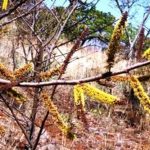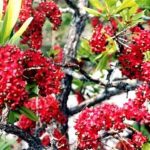TREE LIFE
September 1984
FORTHCOMING CALENDAR
Tuesday September 4th : Botanic Garden Walk. Meet in the Car Park at 1645 for 1700 hours. N.B. Changed day and time as we are now back in summer.
Sunday September 16th : Barnhill Estate, Marondera Ruzawi area, the home of Ian and Jill Hunter. The masasa in this district flush gorgeously a little later than those around Harare and we take advantage of this for our September trip, when we will join up with some Tree Society stalwarts residing in Marondera. Meg C.P. has recced the venue and reports a pleasant mixture of vegetation and a most picturesque kopje to look at. A bus has been booked which will depart from the Monomatapa Car Park at 0815 hours. Fare $12..
MATABELELAND CALENDAR
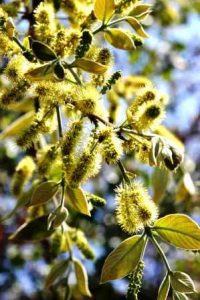
Combretum molle flowering. Photo: Bart Wursten. Source: Flora of Zimbabwe
The Matopos is looking particularly beautiful at present, so many trees being in brilliant colour, Pseudolachnostylis maprouneifolia bright red, Flacourtia indica a deep rich red, Burkea africana bright yellow, Combretum molle a variety of reds, indeed a feast for the eyes! We explored another part of the Arboretum Walk and found much of interest to us, several large specimens of Pappea capensis, a very young Ptaeroxylon obliquum, every leaf of which was red, Calodendrum capensis bearing bright yellow leaves, Tarenna zimbabwensis, Rhus leptodictya, R. pyrsides, to name a few. We then moved on to the Efifi area for lunch, which we had under the Ficus natalensis, we failed to find last month. The valley contains a large number of Olea africana, and we also found an Apodytes dimidiata.
These are the last Matabeleland Notes I shall be writing as I am leaving shortly to go and live in Natal near Howick. My new home is on the edge of a stretch of indigenous Natal forest and any members who find themselves in the area are more than welcome to visit me. I shall need a lot of help in identifying new and different trees. My address will be Box 30, Dargle, Natal 3265.
-Dora Webb
DORA WEBB : I would like to record here, on behalf of all Tree Society of Zimbabwe members, a heartfelt thank you to Dora. Dora has been an active and keen member of Tree Society in Bulawayo for many years, until recently she was Secretary and for the past two years has been in the Chair, and in that post has done a sterling job of holding the Society together especially with having to contend with the chronic poor security situation, which has restricted choice of venues. At the same time Dora has also been a tower of strength in the Ornithological Association. Bulawayo has much to thank Dora for, but I believe we have all enjoyed and appreciated the write-ups which arrive unfailingly each month for Tree Life. Thank you Dora. All the best for your new Natal situation. You will certainly find some of us dropping in to see you and your forest.
-J.P.Haxen
BOTANIC GARDEN WALK, 4TH AUGUST 1984
We really must thank Bob Drummond for a very informative morning in which we examined the fig family, MORACEAE. Just to put this family into a place, according to the taxonomist, Cronquist, the dicotyledons are divided into six subclasses, the smallest, in number of species, is the HAMAMELIDAE. The collection of families in this sub class are generally woody plants which have small flowers without petals and are usually wind pollinated. This group includes most of the common deciduous trees of the northern temperate region, trees like the oak, Quercus, the chestnut, Castanea, the plane, Platanus and the elm, Ulmus. The view has been expressed that these trees invaded the colder regions of the world before the insects and therefore resorted to wind pollination in late winter or early spring so that the seeds had time to ripen in the short rowing season. Most of these trees flower before the leaves appear, but this may have nothing to do with the lack of insects in cold weather as wind pollination is more effective when the trees are bereft of leaves. With this background it is interesting to note the presence within the HAMAMELIDAE of the MORACEAE.
The MORACEAE are named after the mulberry genus, Morus. Although the fruits of the mulberry and fig appear to be very different it is only a simple structural difference, the mulberry consists of numerous petal less flowers pointing outwards, the fig is a collection of flowers pointing inwards, using botanical imagination a fig turned inside out is similar to a mulberry.
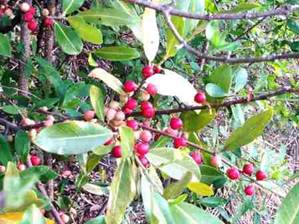
Ficus verruculosa. Photo: Mark Hyde. Source: Flora of Zimbabwe
There is an African mulberry, Morus mesozygia which is found in Mozambique. We began the walk by examining the Ficus verruculosa growing alongside the pond and resembling an overgrown hedgerow. We usually see this species as a low shrub spread eagled across a streamside rock but apparently this growth form is common further west in Okavango. I had somehow missed the connection between warts, verrucas and the lumpy structure on the fruit. The MORACEAE features we noted were the simple, alternate, generally entire leaves, although these are not absolute rules, the small flowers are either male or female and may be borne on the same structure, as in figs, or separate bunches on the same tree, as in the mulberry, or even on separate trees, as in the indigenous Chlorophora. The white milk is also characteristic, particularly of the figs, in many of the other MORACEAE genera there seems to be a more fluid juice which is only faintly milky.
We moved on to a Ficus sycamorus, the tree which Zachaeus climbed in order to have a better view of Jesus. Although some members of the MORACEAE are wind pollinated, the figs have a complicated relationship with wasps which pollinate them, this is complicated by wasps which parasitize the pollinating wasp and trees which cunningly abort figs which are either unfertilized or over parasitized. It is interesting to note that F. sycamorus has been cultivated in the holy lands without their natural pollinating wasps. As a result the unpollinated figs will not ripen naturally. It is customary to damage the young fruit by nipping or stabbing it with a sharp instrument. Some how this ‘fools’ the tree into responding as if the flowers were pollinated and the fruit will ripen. The prophet Amos describes himself as a “herdsman and a nipper of figs of sycamore trees” Amos 7:14. Locally this task is unnecessary as the wasps do the trick on their own and so fertile seed is produced. The biblical term for the tree, ‘sykomorea’ originates from the Greek words syke (fig) and morea (mulberry) – perhaps the Greeks recognized the relationship? F. sycamorus initially has a similar appearance to F. sur, but the leaves have a coarse texture and the bark often develops a ghostly yellow hue.
To help separate the characteristics of the MORACEAE from those of the figs in particular we examined the indigenous Chlorophora excelsa, a large forest tree widely exploited for its wood which is known as Mvule. The leaves are finely serrated with contrasting textures on either side, the top being rough while the undersurface is velvety. The stipules often fall early but many of the MORACEAE have a distinctive stipule scar which surrounds the twig. The scar of both the leaf and stipule often remain as permanent features on the trunk, expanding with the trunk. In Chlorophora the stipular scar does not entirely surround the twig, although it is a distinctive feature of the older branches. A number of enormous specimens are threatened by the erosion of the Tjolotjo cliffs in the south east
The persistent stipular scars were most noticeable in Ficus vallis-choudae, a tree we examined recently when we looked at other high rainfall forest trees. The huge leaves have five veins from the base. Within the forest we felt the abrasive leaves of F. exasperata which are self seeding along the path. Next to the forest stream we found the false fig, Tripepisium madagascariensis, ex Bosqueia. This species had a marked drip tip and many leaves were markedly asymmetrical towards the base. The angular growing bud resembled that of Diospyros but the milky juice and stipular scars were most characteristic of the MORACEAE.
The lone F. bubu is almost a landmark in that part of the forest. This fig is rare throughout its wide range from South Africa northwards towards the Cameroon. Locally it grows in the Burma and Haroni Valleys. We may remember the magnificent F. ingens in the grounds of the Presbyterian Church which was sacrilegiously chopped down. We examined a small specimen of F. platyphylla, ex F. zambeziaca, common at Mana Pools on alluvium in the Valley. The young leaves are a striking red and very velvety. These grow into long tapering leaves with a lobed base.
The last time we examined the figs was when Dr. Berg was out from Holland. Dr. Berg is currently helping to reorganize the MORACEAE and has removed a number of genera which used to be shuffled between the MORACEAE and URTICACEAE and has now created a new family CECROPIACEAE. Within this family can now be found our indigenous Myrianthus holstii, a tree which we became very excited over when we were shown it in the Vumba by the Masons. In contrast to the MORACEAE these rarely have a milky juice. Cronquist describes the leaves as “often so deeply lobed as to appear compound” – well, they fool me into believing they are digitately compound with 5 to 7 large leaflets. The alternate arrangement with persistent, circular stipular scars do indicate its affiliation to the MORACEAE.
Just in closing Bob showed us a small Dorstenia, a plant from Domboshawa which demonstrates the halfway inversion of a fig where the flowers are on a flat receptacle, an interesting transition. We must thank Bob for giving us of his time, we do appreciate it.
-Kim ST.J.Damstra
BUSHMAN’S POINT AND LAKE MCILWAINE ARBORETUM, 19TH AUGUST 1984
We would like to thank Barbara Browning for compiling these notes on the day’s activities.
We started off along the old Kadoma Road and after turning left into the Tynwald Road stopped to look at a specimen of Acacia caffra which is a tree not normally found north of the Limpopo. It was decided that the seed must have been brought up here unknowingly from South Africa by travelers.
We then proceeded to Lake McIlwaine passing through the Game Park, where we saw some ostriches, to Busman’s Point. Sadly, not many of the trees had leaves on them so we had to do a bit more detective work than usual but on the whole we found what we were looking for and were sometimes assisted by labels left by someone who had been there before us. Many of the plants seen were indicators of wet places and in normal times the trees would have been very close to the water.
One of the first things we looked at was Bridelia mollis, with its characteristic conspicuous lateral veins running right to the leaf margin and its round green fruits. This is not a tree that we see very often. Nearby was Dombeya rotundifolia, the wild pear, which had pretty white flowers. It is one of the earliest of the spring flowering trees and was not in leaf but looking around on the ground we found some of the round leaves which give it its specific name.
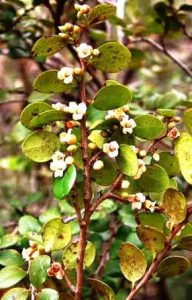
Diospyros natalensis. Photo: Rob Burrett. Source: Flora of Zimbabwe
Moving on, we saw a small example of Diospyros natalensis and later we saw a very much larger one on the kopje. We have not seen it this size since our trip to Saffron Walden which is in the same area. Ximenia caffra, the sour plum, was one of the few trees covered in leaves and also showed us both young and old growth so we were able to compare the bark. The old growth had rough, corky bark while the new growth had smooth bark.
Across the road was Rhus longipes, one of the first trees to come into leaf. It has trifoliate leaves which are apple green in colour and have resin ducts which give Rhus its characteristic smell. It also had small, green flowers.
Growing on the side of the kopje was a tree which we at first mistook for Euclea divinorum but on closer inspection turned out to be Ficus salicifolia. This species which we do not see very often, is the Wonderboom, which is growing just outside Pretoria.
Also on the side of the kopje were Grewia flavescens and G. monticola. The former has a square stem while the latter has a round stem and a pale underside to its leaves.
Next, and conveniently labeled, was Brachylaena rotundata, a member of the Compositae family and an indicator of a wet place. It has a hairy under surface to the leaf, the hairs coming off easily when the leaf is rubbed and has a resemblance to Tarchonanthus, also a member of the Compositae, which we saw at Wolle Kirk’s farm last month.
Not far off was the first of many of the strangling figs which we saw throughout the rest of the day. We conclude that it was Ficus thonningii.
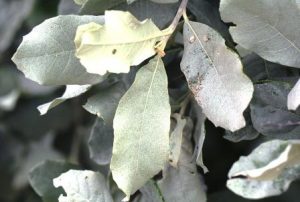
Brachylaena rotundata. Photo: Bart Wursten. Source: Flora of Zimbabwe
Euclea divinorum and E. natalensis were growing close to each other, allowing us to compare the leaves. E. divinorum with its more or less diamond shaped leaves with wavy edges contrasted with the smooth edges of the leaves of E. natalensis. The latter is also easily identified by the dirty, sooty looking underside of its leaves.
We moved off the side of the kopje to an area which would normally be well below the water level and we were able to read a sign telling us that landing was prohibited. Looking up to the edge of the kopje we saw Cassia abbreviata, distinguishable by the one long narrow pod which was visible. The tree was an unusually large specimen. Next to it was Commiphora mollis with its characteristic peeling bark and two specimens of Erythrina abyssinica which were just coming into flower.
Further on was Dalbergia nitidula with its dark bark and very light green leaves. Again, we do not normally see such a big specimen. We also saw Pterocarpus angolensis, mukwa, with its very characteristic bristly pods and rough bark and Parinari curatellifolia which had a yellowish leaves and was not looking very characteristic at all.
At this stage the group split, some of us climbing up into the kopje while the others walked round. On the kopje we found Tricalysia angolensis, a member of the RUBIACEAE family, which bears its buds all winter. It has powdery looking leaves with the odd shiny bit.
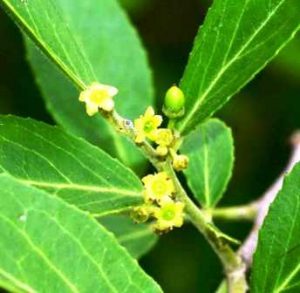
Cassine aethiopica. Photo: Rob Burrett. Source: Flora of Zimbabwe
There was a good example of Maytenus undata showing the black glands in the teeth of the leaf and the leaves were paler on the underside from a white, almost powdery bloom which rubs off easily and gives a musty smell. After lunch while on our way to see the Bushman painting we were lucky enough to see Cassine aethiopica which can easily be confused with Maytenus undata but does not have the little black glands and on testing, the leaves did not have the same smell.
Once we had seen the painting we ambled to the Tree Society Arboretum hoping to see a bit of game on the way. Except for the ostriches, the only animals we saw were in the distance but it made a pleasant drive. George and Margaret Hall were waiting for us at the Arboretum and told us the history of the place and gave us a guided tour.
The Tree Society took over the land shortly after Lake McIlwaine had filled, in the early months of 1952. It consisted of a hill of banded iron stone which had been clear felled for firewood production some years before and the annual grass burn had kept regeneration at bay. Working from a survey by Mr. Jack Reid, contour paths were laid out. In those days exotics were regarded as being just as important as indigenous trees and so, many were planted. Today very few of them are still surviving.
We walked along the road by the lake edge and saw, among others, Acacia amythethophylla, A. nigrescens, Albizia antunesiana, Bridelia cathartica, Burkea africana, Cassia singueana with its yellow flowers, Combretum zeyheri in fruit, Ochna schweinfurthiana, Pseudolachnostylis maprouneifolia, Uapaca kirkiana, Zanha africana and Craibia brevicaudata which are typical forest trees were planted as was Chlorophora excelsa which is normally found in low altitude evergreen forest.
Those of us with any energy climbed the hill where we saw Garcinia buchananii, which usually has yellow milk in the leaves but it was difficult to see, probably due to the drought, Kirkia acuminata, Lannea discolor with its “E.T . Fingers” Pleurostylia africana and we were rewarded at the top by the sight of Ficus abutilifolia, a specimen of Euclea natalensis in flower and a wonderful view over to the Darwendale Dam. Our thanks to George and Margaret for showing us around.
-B.Browning
ROOT NOTE The Bulawayo write up last month inquired about rootling around the base of Elephantorrhiza goetzei. Steven Mavi of the Herbarium confirms that this tree is a popular medicine used to cure dysentery, and especially for a depressed fontanels in young children. This condition results from dehydration. The roots are either dried and ground, or infused into a drink. While in the Matopos they also noted a Hexalobus monopetalus on which we note the spherical growths on the stems. We think they could have been the petioles of the leaves which have dropped. I examined the specimen in the Botanic Gardens to discover it was also covered in these small growths which are a dark brown colour and have a velvety texture. This tree was probably further developed than the one in the Matopos as these flower buds were beginning to open. The buds develop along the stem in the axils of the leaves, although often many of the leaves have fallen, this may have resulted in the confusion. Thank you for these queries, they lead us to examine things a bit better.
-Kim ST.J.Damstra
ROOT NOTE Tree Life would be much improved by a greater variety, especially in the root notes department. Any short note will be most welcome, and if you wish, contributions can be kept anonymous – we would particularly appreciate positive contributions which correct the mistakes which we make – we are acutely aware of our limited knowledge and often forge ahead in ignorance. We learn much from our mistakes and will not feel offended to be told we are wrong.
-Kim ST.J.Damstra & J.P.Haxen
ROOT NOTE My obsession with strange vegetative features which characterize a family or group of families may have become obvious through these lines. A recent reference drew attention to the twigs of the MONIMIACEAE which a ‘commonly somewhat flattened at the nodes’. This feature works well on our indigenous Oxymalos monospora a tree which is often shunted between this family and the TRIMENIACEAE, but currently sits along with the other flattened nodes of the MONIMIACEAE.
-Kim ST.J.Damstra
THE MAN WHO PLANTED TREES AND GREW HAPPINESS – Jean Giono
Jean Giono, the only son of a cobbler and a laundress, was one of France’s greatest writers. His prodigious literary output included stories, essays, poetry, plays, filmscripts, translations and over thirty novels, many of which have been translated into English. Giono was a pacifist, and was twice imprisoned in France at the outset and conclusion of World War II. He remained tied to Provence and Manosque, the little city where he was born in 1895 and, in 1970,died.
Giono was awarded the Prix Bretano, the Prix de Monaco (for the most outstanding collected work by a French writer), the Légion d’Honneur, and he was a member of the Académie Goncourt.
For a human character to reveal truly exceptional qualities one must have the good fortune to be able to observe its performance over many years. If this performance is devoid of all egoism, if its guiding motive is unparalleled generosity, if it is absolutely certain that there is not thought of recompense and that, in addition, it has left its visible mark upon the earth, then there can be no mistake.
About forty years ago I was taking a long trip on foot over mountain heights quite unknown to tourists in that ancient region where the Alps thrust down into Provence. All this, at the time, I embarked upon my long walk through these deserted regions, was a barren and colourless land. Nothing grew there but wild lavender.
I was crossing the area at its widest point, and after three days’ walking found myself in the midst of unparalleled desolation. I camped near the vestiges of an abandoned village. I had run out of water the day before and had to find some. These clustered houses, although in ruins, like an old wasps’ nest, suggested that there must once have been a spring or a well here. There was, indeed, a spring, but it was dry. The five or six houses, roofless, gnawed by wind and rain, the tiny chapel with its crumbling steeple, stood about like the houses and chapels in living villages, but all life had vanished.
It was a fine June day, brilliant with sunlight, but over this unsheltered land, high in the sky, the wind blew with unendurable ferocity. It growled over the carcasses of the houses like a lion disturbed at its meal. I had to move my camp. After five hours walking I had still not found water, and there was nothing to give me any hope of finding any. All about me was the same dryness, the same coarse grasses. I thought I glimpsed in the distance a small black silhouette, upright, and took it for the trunk of a solitary tree. In any case I started towards it. It was a shepherd. Thirty sheep were lying about on the baking earth.
He gave me a drink from his water gourd and, a little later, took me to his cottage in a fold of the plain. He drew his water, excellent water, from a very deep natural well above which he had constructed a primitive winch.
The man spoke little. This is the way of those who live alone, but one felt that he was sure of himself, and confident in his assurance. That was unexpected in this barren country. He lived, not in a cabin, but in a real house built of stone that bore plain evidence of how his own efforts had reclaimed the ruin he had found there on his arrival. His roof was strong and sound. The wind on its tiles made the sound of the sea upon its shores.
The place was in order, the dishes washed, the floor swept, his rifle oiled; his soup was boiling over the fire. I noticed then that he was cleanly shaved, that all his buttons were firmly sewed on, that his clothing had been mended with the meticulous care that makes the mending invisible. He shared his soup with me and afterwards, when I offered my tobacco pouch, he told me that he did not smoke. His dog, as silent as himself, was friendly without being servile.
…………………………… to be continued
(With acknowledgements to The Men of the Trees)
-PHILIP HAXEN CHAIRMAN


